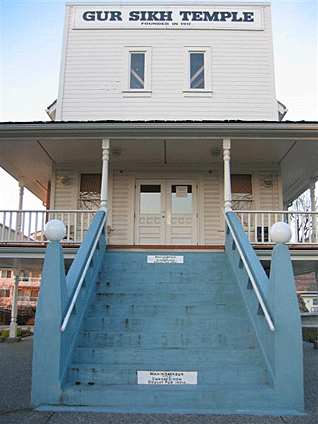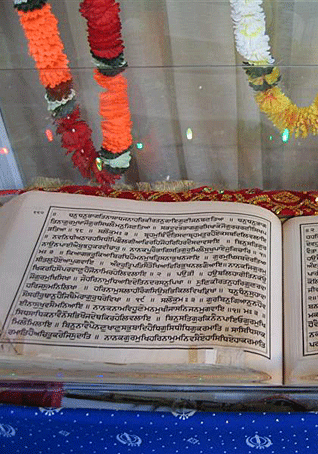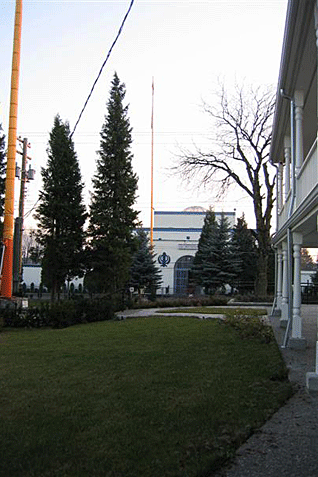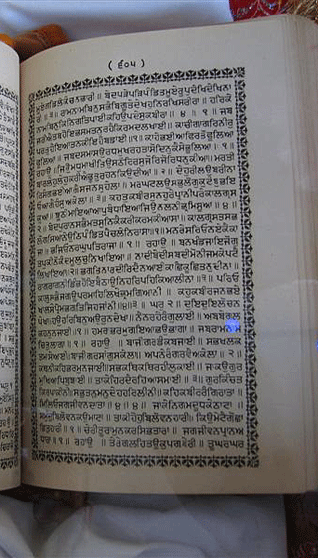
Photos: Above - Abbotsford's historic GurSikh Temple, founded 1911. Below, 1st from bottom - Century-old Guru Granth Sahib. 2nd from bottom: View of the new gurdwara from the old. 3rd from bottom: Antique Guru Granth Sahib, published in Lahore.



History
A Precious Find
by NICOLA MOONEY
Like gurdwaras around the globe, the Khalsa Diwan Society Gurdwara in Abbotsford, British Columbia, Canada, recently marked Guru Nanak Dev Ji's gurparab in the traditional manner, with an akhand paath held over three days. As usual, the event was a time to celebrate the birth of Guru Nanak, and to reflect on individual and community commitments to Sikhi.
But this year's gurparab was heightened by the display of, and the chance to read and bow before, not one, but two heirloom volumes of the Guru Granth Sahib that were recently discovered on the gurdwara premises.
Rather than utilizing these sacred texts in the akhand paath celebrating the gurpurab, such that only those few persons reading the scriptures would be able to encounter them closely, the Guru Granth Sahibs were placed in a temporary display case. As befitting their status, the antique texts sat on an elevated platform, swathed in rumaalas, beneath a canopy festooned with lights. Devotees had the chance to pay obeisance to The Word, read the pages to which they were opened, take photographs, or do all three. This public display seemed in true keeping with Sikhism's egalitarian spirit and, in a particularly nice touch, the display was mounted in the women's side of the durbar hall.
These precious heirlooms were discovered, as precious heirlooms often are, in prosaic circumstances.
Earlier this year, the gurdwara's granthi and several members of the Khalsa Diwan Society were sorting through and assessing the condition of the gurdwara's collection of Guru Granth Sahibs which circulate through the community, borrowed for paaths, kirtans and langars held in local Sikh homes. They were both surprised and delighted to discover two antique texts: one going back to sometime early in the 20th century and the other certainly dating back an entire century.
While the first volume does not bear a publication date, it is almost certainly more than sixty years old, as it was printed by M/s Rai Sahib Munshi Gulab Singh & Sons of Mufeedaam Press, Lahore. Rather than the 1430 pages that are now standard, this large volume is printed on 1937 pages. The second volume, at 1323 pages, printed in a smaller format, most likely for home use, bears the words "New West 1908" on its frontispages.
Interestingly, in both volumes, while the verses are spaced, their words are printed continuously. This would seem to indicate that greater skills of recitation were prevalent in the past, and perhaps relatedly, that the experience of reading and hearing the bani was in some ways different from today.
According to Khalsa Diwan Society Vice-President, Baljinder Singh Bains, who discovered the smaller of the antique Guru Granth Sahibs, the Society plans to make the display of both of these precious heirlooms a feature of future sangraands and gurparabs, as well as Vaisakhi and other festivals. The Society also intends to make appropriate efforts to conserve the physical aspects of the texts, although at present, while showing some inevitable evidence of minor wear and tear about the edges of their pages, the sacred texts seem in remarkably good condition.
It is rare to come across such compelling pieces of material history and culture. After all, many immigrant communities are constrained in what they can bring from their original homes, as well as in what they are able to acquire in their new ones. But of course, it is not surprising that the Guru Granth Sahib should be one of the few things to survive from the community's early history; undoubtedly an object of daily use, it is also an object of reverence. As both the body of Sikh scripture and the embodiment of the Guru - learning and teaching, symbol and presence - the Guru Granth Sahib is afforded great material care.
While Abbotsford's historic Guru Granth Sahibs speak ultimately of the symbolic importance of the Guru's word as Guru, they also speak to the century-long history of Sikhs in British Columbia. Abbotsford's Khalsa Diwan Society is among the oldest in North America, and its Gur Sikh Temple, built over three years from 1908 - 1911, is the oldest extant gurdwara on the continent. This simple timber structure, constructed in the style of other local buildings at the time, comprises, like most North American gurdwaras, an upper diwan hall and a lower langar hall. The very construction of the temple encapsulates Sikh endurance and commitments to faith in the diaspora: Sikhs working at a local mill, owned by the Trethewey family, convinced their employers to donate the building's lumber, and then carried the lumber to the temple site, apparently on their backs.
Declared a National Historic Site in 2002 and recently restored under the auspices of Parks Canada, the Gur Sikh Temple sits directly across the road from a bigger, more modern building that now serves Abbotsford's large and growing Sikh population. Driving up the hill on South Fraser Way towards the gurdwaras, one is immediately struck by the sight of two nishan sahibs standing proudly at the hill's crest. Upon arriving to visit, one is further struck by the fact that the two flags represent a single gurdwara entity, past and present, and thus a continuous history of community cohesion.
The Centre for Indo-Canadian Studies at the University College of the Fraser Valley is embarking upon a local history project to coincide with the Abbotsford gurdwara's centennial in 2011. It is hoped that other treasures from the past, whether in the forms of material, textual, or more intangible expressions of personal and collective memory, will emerge in the undertaking of this project.
Anyone with material, personal or family memories of Abbotsford's early Sikh community is encouraged to contact the project by e-mail at: cics@ucfv.ca. Further information on the Centre for Indo-Canadian Studies can be found at: http://www.ucfv.ca/CICS.htm.
[Dr. Nicola Mooney teaches Anthropology in the Social, Cultural and Media Studies Department of the University College of the Fraser Valley and is Adjunct Professor of Anthropology at Mount Allison University. Her book, Rural Nostalgias and Transnational Dreams, will be published by the University of Toronto Press in 2008.]
Photographs: Courtesy, Dildeep Singh Dhillon and Nicola Mooney.
Conversation about this article
1: Ruby Kaur (Oxford, England), December 04, 2007, 10:53 PM.
This must be the oldest Gurdwara in the world outside India? Could anyone confirm if this is so?
2: Satvir Kaur (Boston, U.S.A.), December 05, 2007, 8:46 AM.
Oldest in the western world, maybe. But outside India/Pakistan, there must be gurdwaras in Afghanistan (if there are any left) or other countries that Guru Nanak visited during His udasis.
3: Lakhvir (Nairobi, Kenya), December 05, 2007, 8:59 AM.
A Gurudwara in Kenya, Landhies Railway, was built in 1903 and there is photographic evidence. The first in Africa, however, was built in 1898 at Kilindini (Mombasa, Kenya) during the arrival of the Sikhs to build the Kenya-Uganda Railway. Perhaps there are gurdwaras older than these, probably in Malaysia or South East Asia. Would be interesting to know.
4: Gurcharan Singh Kulim (London/Kuala Lumpur), December 05, 2007, 3:18 PM.
I am surprised there is no mention of the Guru Granth Sahib Bir found at a Dacca gurdwara, written in hand, and partly burnt and damaged. Studies are being conducted presently. But this news does not seem to have broken out in the English media.
5: Satwinder Bains (Abbotsford, British Columbia, Canada), December 05, 2007, 6:28 PM.
This is not the oldest gurdwara in the world outside of India, but is the oldest one in the Americas. It is heartening to see the wisdom of the current caretakers to create heritage status for our future generations. Otherwise, much can be lost just through the passage of time.
6: Savraj Singh (U.S.A.), December 06, 2007, 8:18 AM.
The article says this gurdwara was founded in 1911. That makes it just a year older than the gurdwara in Stockton, California. See this link for more info: http://www.sikhpioneers.org/chrono.html
7: I.J. Singh (New York, U.S.A.), December 06, 2007, 9:02 AM.
Much appreciated report on our heritage in North America. I had read somewhere of a gurdwara in El Centro, California, dating 1906. Is this correct or am I mistaken? Can readers enlighten us?
8: Jaggi Singh (Sarnia, Canada), December 06, 2007, 7:59 PM.
Many thanks to Dr. Nicola Mooney and S. Dildeep S. Dhillon for sharing with us a vital chapter of Sikh-Canadian history. The Khalsa Diwan Society has to be commended for preserving these precious scriptures.
9: Baljinder Bains (Abbotsford, British Columbia, Canada), December 06, 2007, 11:20 PM.
Many thanks to Dr. Nicola Mooney and S. Dildeep S. Dhillon for writing this article and presenting the pictures of the two old volumes of the Guru Granth to the sangat.
10: Manjit Rai (Brampton, Ontario, Canada), December 13, 2007, 9:36 PM.
Many thank to Nicola & Dildeep for sharing yet another chapter of enriching Sikh history. I'm sure there are gurudwaras in Iran and/or Iraq which may be older that this one. Still, for all of us Sikh-Canadians, it is something to be proud of.
11: Priyanka Dhawan (British Columbia, Canada), December 17, 2007, 5:54 PM.
I am amazed to learn about the oldest gurdwaras outside of India and Pakistan. As much as its overwhelming for me to know about the establishment of these gurudwaras in the late 1800s and early 1900s, it is also very astonishing to see how the Sikh families in that era strived to build beautiful gurdwaras in countries like Canada or Kenya. It is really commendable how the Sikhs who settled in the 1800s have managed to establish such a strong foundation of Sikh religion and culture in most of the countries across the globe. It is because of these people that we feel at home even miles away from India and Pakistan.
12: K. Balbir Singh Dhillon (Ganga Nagar, Rajasthan, India), December 17, 2007, 9:37 PM.
It is really very significant to find two very old scriptures in perhaps the oldest gurdwara of North America. The number of pages and the type of printing also indicates their antiquity. It may be added here that the printing of the verses continuously in the scriptures was the practice since the beginning as the scriptures were hand written and all words were written continuously. Even with the advent of the press, the practice continued. And, even today, the granthis recite from the scripture with continuous printed words in Darbar Sahib, Amritsar; of course, experienced granthis can read such scriptures. I think the modern practice of printing separate words was adopted to facilitate readings by all.
13: Jagseer Gill (Brampton, Canada), December 29, 2007, 10:56 AM.
Many thanks to both of you. You always bring up somthing new and historic. Please keep up this work.
14: Pardeep Singh Rai (London, Britain), December 01, 2008, 9:32 AM.
The first gurdwara in Malaysia was built in 1881 in Fort Cornwallis, Penang. See the book, 'Sikh Gurdwaras in Malaysia and Singapore: An Illustrated History 1873-2003', by Saran Singh Sidhu.
15: Nicola (California, United States), April 29, 2009, 1:35 PM.
Dudeeeeeeee ... you have the same name as meee! That's freaking saweeett!


